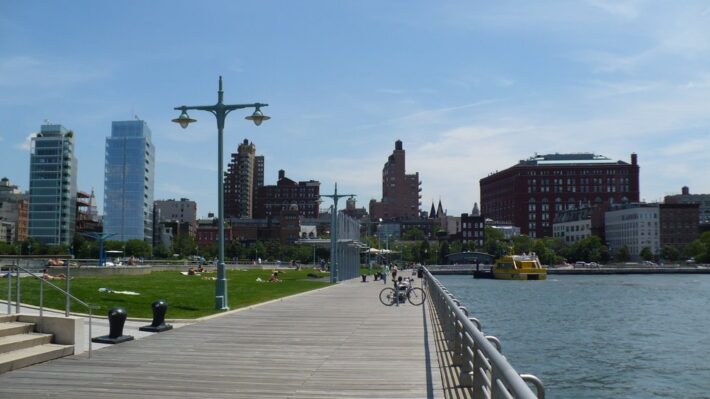
The Waterfront Alliance, a nonprofit that works to influence waterfront policy and planning, had a meeting on October 8 with Manhattan Community Board 4 to promote a new set of guidelines for the development of waterfront projects in the district.
The Alliance created the Waterfront Edge Design Guidelines (WEDG) an incentive-based ratings system, to assist waterfront developers with designs that are environmentally sound and publicly accessible. Michael Porto, the director of outreach and planning for WEDG, met with members of the board’s Waterfront, Parks & Environment committee to encourage the group to adopt the guidelines for projects in Hell’s Kitchen and Chelsea.
“WEDG is the first plan of its kind in the nation,” said Porto, citing the guidelines would be used as a tool for best practices to protect vulnerable waterfront sites from events like Hurricane Sandy.
The guidelines, launched in January 2015, were inspired by the Department of City Planning’s 2011 report, “Vision 2020: New York City Comprehensive Waterfront Plan,” and provide specific steps for the development of residential and commercial properties and parks, as well as industrial and maritime sites along the waterfront. Projects can earn points for incorporating such items like transit access, facilities and scenic views into the design. The projects that earn the minimum required points are awarded WEDG certification.
Some committee members were skeptical of Porto’s intentions, however. “Are you looking to us to ask developers to come to you?” asked Lowell Kern. Porto responded that the Alliance was, in fact, reaching out to other community boards to promote WEDG.
The guidelines are still in their early stages, but have garnered approval from two Manhattan community boards. Porto said that Community Board 1, representing Lower Manhattan, voted for the WEDG project. “CB1 supported us before the guidelines were even finished,” said Porto who claimed the board cited Hurricane Sandy as a cautionary tale for building resilient waterfront edges. Most recently, Manhattan Community Board 6, representing the east side of Manhattan from 14th street to 59th street, voted in favor of using the guidelines.
Brett Firfer, an architect and committee member, pointed out that much of the waterfront in Community Board 4 is under the jurisdiction of the Hudson River Park Trust (HRPT), a joint state and city collaboration. “If you talk to them, you’ll get like 30 percent of the Manhattan coast,” he said.
Kern suggested sending a letter to the Hudson River Park Trust encouraging them to look at the guidelines, but he did question the WEDG project’s credentials.
Porto said Brooklyn Bridge Park is an example of a WEDG certified project. The park’s native plants provide habitats for a wide range of species; its marina has berthing for 120 boats; and salvaged materials have been repurposed on the property to create a multi-functional waterfront, he said. There are also other city-owned projects interested in using WEDG, including Hunter’s Point South, an affordable housing development in Long Island City, Porto added.
Maarten de Kadt, co-chair of the committee, asked what the procedure was when a waterfront developer approaches the WEDG team. “The developer would submit as much information as possible,” said Porto. “It’s usually a back and forth process, and I meet with a lot of architects and engineers on my side. We don’t have a third party yet.”
The WEDG project team consists of two staff members, including Porto and an intern who now works full time. “We could have had 10 people and it still wouldn’t have been enough,” said Porto. “We’re trying to find more money to scale up.”
While the committee unanimously decided to make HRPT aware of WEDG, Firfer emphasized that the committee should “encourage” the project, as opposed to “urge.”
De Kadt said that the committee would send a letter to HRPT, but that it needed to learn more about the guidelines before issuing a full endorsement. “We don’t want to make you the ultimate authority,” he said, pointing out that Porto didn’t seem much of a waterfront expert, but rather a middle man.
Noreen Doyle, executive vice president of HRPT, said they are aware of WEDG. “We were participants in the planning process for it, specifically for the public access portions.” But she suggested that the guidelines had limitations. “For example, Hudson River Park has a historic bulkhead, and it cannot be removed to create a soft, habitat friendly edge even if that were to score us more points,” she said.
Doyle added that the Hudson River Park has an existing master plan, as well as legislation and regulatory permits governing the waterfront construction. The Trust believes that WEDG is a useful tool, but it doesn’t have 100 percent applicability for Hudson River Park. “I’m pretty sure the Waterfront Alliance never envisioned that they would,” said Doyle.
“Even if future development projects don’t achieve or use WEDG certification, at the very least we want people to use it as a tool,” said Porto.